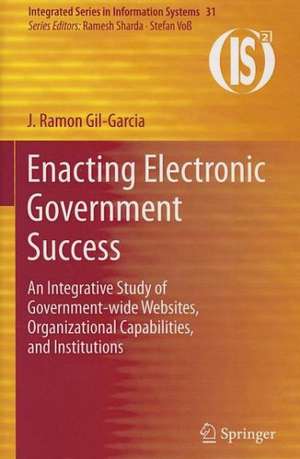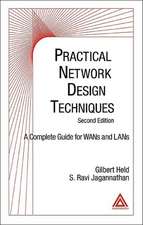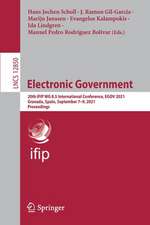Enacting Electronic Government Success: An Integrative Study of Government-wide Websites, Organizational Capabilities, and Institutions: Integrated Series in Information Systems, cartea 31
Autor J. Ramon Gil-Garciaen Limba Engleză Hardback – 28 feb 2012
Theoretically, the book proposes a way to quantitatively operationalize Fountain’s enactment framework. Based on the institutional tradition, the technology enactment framework attempts to explain the effects of organizational forms and institutional arrangements on the information technology used by government agencies. According to Fountain (1995; 2001) the technology enactment framework pays attention to the relationships among information technology, organizations, embeddedness, and institutions. This framework is very well known in the e-government field, but is normally used for qualitative analysis and there is no previous proposal of how to use it with quantitative data. The book proposes variables to measure each of the different constructs in this framework and also tests the relationships hypothesized by Fountain’s theory. Finally, using the advantages of the selected quantitative analysis technique (Partial Least Squares), the study also proposes some adjustments and extensions to the original framework in a theory building effort.
Methodologically, the book reports on one of the first multi-method studies in the field of e-government in general and e-government success in particular. This study uses a nested research design, which combines statistical analysis with two in depth case studies. The study begins with a statistical analysis using organizational, institutional, and contextual factors as the independent variables. An overall score representing e-government success in terms of the functionality of state websites is the dependent variable. Second, based on the statistical results two cases are selected based on their relative fitness to the model (residuals) and their position in the general ranking of website functionality (which includes four different measures). In order to complement the results of the statistical analysis,case studies were developed for the two selected states (New York and Indiana), using semi-structured interviews and document analysis. In terms of the statistical analysis, the book constitutes one of the first applications of Partial Least Squares (PLS) to an e-government success study. PLS is a structural equations modeling (SEM) technique and, therefore, allows estimating the measurement model and the structural model simultaneously. The use of this sophisticated statistical strategy helped to test the relationships between e-government success and different factors influencing it, as well as some of the relationships between several of the factors, thus allowing exploring some indirect effects too.
| Toate formatele și edițiile | Preț | Express |
|---|---|---|
| Paperback (1) | 644.33 lei 6-8 săpt. | |
| Springer – 12 apr 2014 | 644.33 lei 6-8 săpt. | |
| Hardback (1) | 649.28 lei 6-8 săpt. | |
| Springer – 28 feb 2012 | 649.28 lei 6-8 săpt. |
Din seria Integrated Series in Information Systems
- 15%
 Preț: 646.62 lei
Preț: 646.62 lei - 20%
 Preț: 996.07 lei
Preț: 996.07 lei - 20%
 Preț: 1272.94 lei
Preț: 1272.94 lei -
 Preț: 389.11 lei
Preț: 389.11 lei - 20%
 Preț: 998.04 lei
Preț: 998.04 lei - 15%
 Preț: 654.43 lei
Preț: 654.43 lei - 20%
 Preț: 1933.71 lei
Preț: 1933.71 lei -
 Preț: 388.52 lei
Preț: 388.52 lei - 15%
 Preț: 646.11 lei
Preț: 646.11 lei - 15%
 Preț: 667.71 lei
Preț: 667.71 lei - 15%
 Preț: 711.89 lei
Preț: 711.89 lei -
 Preț: 393.52 lei
Preț: 393.52 lei - 15%
 Preț: 644.82 lei
Preț: 644.82 lei - 18%
 Preț: 955.25 lei
Preț: 955.25 lei - 5%
 Preț: 1280.25 lei
Preț: 1280.25 lei - 15%
 Preț: 580.97 lei
Preț: 580.97 lei - 15%
 Preț: 638.11 lei
Preț: 638.11 lei - 20%
 Preț: 1277.24 lei
Preț: 1277.24 lei - 20%
 Preț: 1215.14 lei
Preț: 1215.14 lei - 20%
 Preț: 638.37 lei
Preț: 638.37 lei - 5%
 Preț: 1801.57 lei
Preț: 1801.57 lei - 18%
 Preț: 952.72 lei
Preț: 952.72 lei - 15%
 Preț: 653.14 lei
Preț: 653.14 lei - 20%
 Preț: 995.75 lei
Preț: 995.75 lei
Preț: 649.28 lei
Preț vechi: 811.60 lei
-20% Nou
Puncte Express: 974
Preț estimativ în valută:
124.25€ • 134.92$ • 104.37£
124.25€ • 134.92$ • 104.37£
Carte tipărită la comandă
Livrare economică 22 aprilie-06 mai
Preluare comenzi: 021 569.72.76
Specificații
ISBN-13: 9781461420149
ISBN-10: 1461420148
Pagini: 372
Ilustrații: XXX, 254 p.
Dimensiuni: 155 x 235 x 22 mm
Greutate: 0.52 kg
Ediția:2012
Editura: Springer
Colecția Springer
Seria Integrated Series in Information Systems
Locul publicării:New York, NY, United States
ISBN-10: 1461420148
Pagini: 372
Ilustrații: XXX, 254 p.
Dimensiuni: 155 x 235 x 22 mm
Greutate: 0.52 kg
Ediția:2012
Editura: Springer
Colecția Springer
Seria Integrated Series in Information Systems
Locul publicării:New York, NY, United States
Public țintă
Professional/practitionerCuprins
E-Government Success: Definition, Measures, and Factors.- E-Government Success and the Ensemble View of Information Technology.- Identifying E-Government Success Factors: A Statistical Analysis.- Enacting the Government-Wide New York State Website.- Enacting the Government-Wide Indiana Website.- Understanding E-Government Success: Discussion and Implications.- Conclusions.
Recenzii
From the reviews:
“Enacting Electronic Government Success can be considered a reference book for U.S. state officials who seek to understand how best to evaluate the positive and negative aspects of their e-government strategy. … This highly useful book presents an integrative framework to evaluate e-government initiatives. … This readable and comprehensive book is a genuine service to public administrators present and future, who hope to thoughtfully advance government service delivery into the information age.” (Sehl Mellouli, Public Administration Review, Vol. 47 (2), 2014)
“Ramon Gil-Garcia has authored a first-class book about electronic government (e-government), and one that will inspire scholars for years. … This book is an integrative contribution to the emergent e-government research community and fulfils some of the existing pitfalls in the discipline. … The audiences of this book will find it useful both in the academic and practical realms. … Future researchusing this Enacting Electronic Government Success model may be developed.” (J. Ignacio Criado, Information Polity, Vol. 18, 2014)
“Enacting Electronic Government Success can be considered a reference book for U.S. state officials who seek to understand how best to evaluate the positive and negative aspects of their e-government strategy. … This highly useful book presents an integrative framework to evaluate e-government initiatives. … This readable and comprehensive book is a genuine service to public administrators present and future, who hope to thoughtfully advance government service delivery into the information age.” (Sehl Mellouli, Public Administration Review, Vol. 47 (2), 2014)
“Ramon Gil-Garcia has authored a first-class book about electronic government (e-government), and one that will inspire scholars for years. … This book is an integrative contribution to the emergent e-government research community and fulfils some of the existing pitfalls in the discipline. … The audiences of this book will find it useful both in the academic and practical realms. … Future researchusing this Enacting Electronic Government Success model may be developed.” (J. Ignacio Criado, Information Polity, Vol. 18, 2014)
Textul de pe ultima copertă
Many countries around the world are investing a great amount of resources in government IT initiatives. However, few of these projects achieve their stated goals and some of them are complete failures. Therefore, understanding e-government success has become very important and urgent in recent years. In order to develop relevant knowledge about this complex phenomenon, researchers and practitioners need to identify and assess what are the main conditions, variables, or factors that have an impact on e-government success. However, before being able to evaluate these impacts, it is necessary to define what e-government success is and what some e-government success measures are. This book presents a review of both e-government success measures and e-government success factors. It also provides empirical evidence from quantitative analysis and two in-depth case studies. Although based on sound theory and rigorous empirical analysis, the book not only significantly contributes to academic knowledge, but also includes some practical recommendations for government officials and public managers.
Theoretically, the book proposes a way to quantitatively operationalize Fountain’s enactment framework. Based on the institutional tradition, the technology enactment framework attempts to explain the effects of organizational forms and institutional arrangements on the information technology used by government agencies. According to Fountain (1995; 2001) the technology enactment framework pays attention to the relationships among information technology, organizations, embeddedness, and institutions. This framework is very well known in the e-government field, but is normally used for qualitative analysis and there is no previous proposal of how to use it with quantitative data. The book proposes variables to measure each of the different constructs in this framework and also tests the relationships hypothesized by Fountain’s theory. Finally, using the advantages of the selected quantitative analysis technique (Partial Least Squares), the study also proposes some adjustments and extensions to the original framework in a theory building effort.
Methodologically, the book reports on one of the first multi-method studies in the field of e-government in general and e-government success in particular. This study uses a nested research design, which combines statistical analysis with two in depth case studies. The study begins with a statistical analysis using organizational, institutional, and contextual factors as the independent variables. An overall score representing e-government success in terms of the functionality of state websites is the dependent variable. Second, based on the statistical results two cases are selected based on their relative fitness to the model (residuals) and their position in the general ranking of website functionality (which includes four different measures). In order to complement the results of the statistical analysis, case studies were developed for the two selected states (New York and Indiana), using semi-structured interviews and document analysis. In terms of the statistical analysis, the book constitutes one of the first applications of Partial Least Squares (PLS) to an e-government success study. PLS is a structural equations modeling (SEM) technique and, therefore, allows estimating the measurement model and the structural model simultaneously. The use of this sophisticated statistical strategy helped to test the relationships between e-government success and different factors influencing it, as well as some of the relationships between several of the factors, thus allowing exploring some indirect effects too.
Theoretically, the book proposes a way to quantitatively operationalize Fountain’s enactment framework. Based on the institutional tradition, the technology enactment framework attempts to explain the effects of organizational forms and institutional arrangements on the information technology used by government agencies. According to Fountain (1995; 2001) the technology enactment framework pays attention to the relationships among information technology, organizations, embeddedness, and institutions. This framework is very well known in the e-government field, but is normally used for qualitative analysis and there is no previous proposal of how to use it with quantitative data. The book proposes variables to measure each of the different constructs in this framework and also tests the relationships hypothesized by Fountain’s theory. Finally, using the advantages of the selected quantitative analysis technique (Partial Least Squares), the study also proposes some adjustments and extensions to the original framework in a theory building effort.
Methodologically, the book reports on one of the first multi-method studies in the field of e-government in general and e-government success in particular. This study uses a nested research design, which combines statistical analysis with two in depth case studies. The study begins with a statistical analysis using organizational, institutional, and contextual factors as the independent variables. An overall score representing e-government success in terms of the functionality of state websites is the dependent variable. Second, based on the statistical results two cases are selected based on their relative fitness to the model (residuals) and their position in the general ranking of website functionality (which includes four different measures). In order to complement the results of the statistical analysis, case studies were developed for the two selected states (New York and Indiana), using semi-structured interviews and document analysis. In terms of the statistical analysis, the book constitutes one of the first applications of Partial Least Squares (PLS) to an e-government success study. PLS is a structural equations modeling (SEM) technique and, therefore, allows estimating the measurement model and the structural model simultaneously. The use of this sophisticated statistical strategy helped to test the relationships between e-government success and different factors influencing it, as well as some of the relationships between several of the factors, thus allowing exploring some indirect effects too.
Caracteristici
The first monograph to present systematic data on the effective modeling of E-Government success factors Applies Partial Least Squares analysis and enriches the results with two real-life cases Author is a rising star in the field Includes supplementary material: sn.pub/extras

















